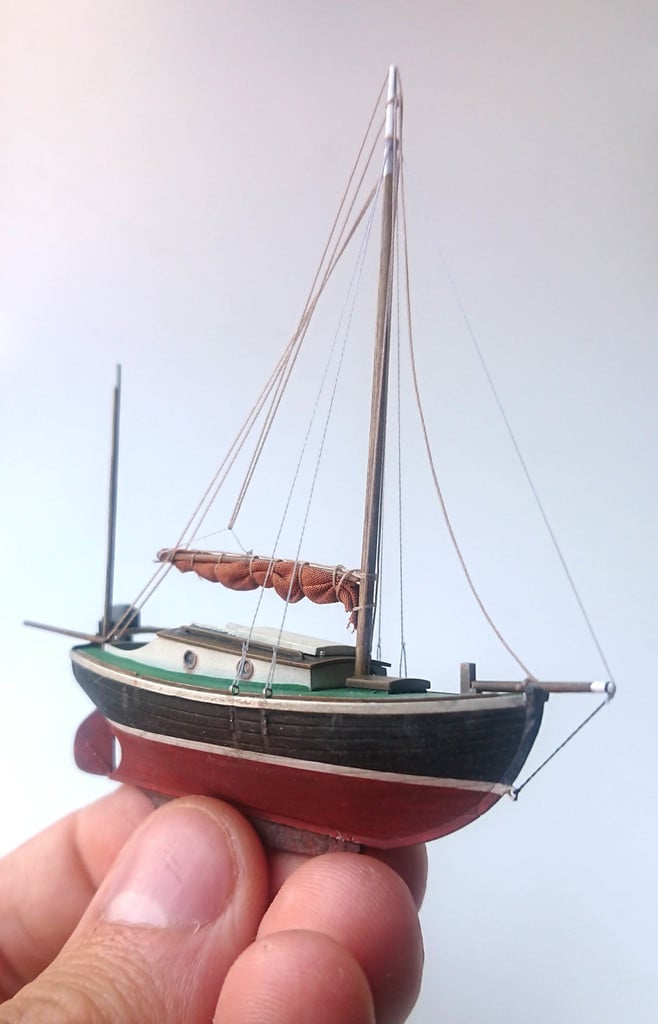
Sailing Lugger "Storm Petrel" - 1:87 scale
thingiverse
<h2>Storm Petrel:</h2> A scale model of the sailing boat 'Storm Petrel' found on a quayside on the Isle of Arran in Scotland. Built by David Hillyard in 1949, she's a carvel-built, 3.5 ton, 18-foot sailing yawl with a lugsail on the main and mizzen. She sank, battered in Corrie harbour by a storm some years ago, and sat on Lamlash hard standing for a while in a bit of a sorry state during which time I decided to make a 3D scan to preserve the hull lines. Using photographs from the owner I then reconstructed the rest of the superstructure. She didn't have an inboard motor during the period of history I know of, but I've included an appropriate propeller in case the builder wants to add it - a short length of wire will be needed as a shaft. Also included is the Yamaha 4hp outboard that was fitted on the transom outboard bracket. I've made the iron keel a separate piece, which can be affixed with a few small 0.5mm pins through the printing vent holes. <h2>Build Tips:</h2> For the masts, the mainmast should be cut from 1.5mm diameter stock, cut to a length of 68mm, and tapered to a diameter of 0.8mm at one end. The final height measured from the deck should be 63mm. the mizzenmast should be cut from 1mm diameter stock, cut to a length of 37mm, and tapered to a diameter of 0.6mm at one end. The final height measured from the deck should be 36mm. For the bowsprit and bumpkin, they are cut from Ø1 x 13.5mm and Ø0.8 x 20mm respectively. The mainsail yard is Ø0.5 x 33mm, and the mizzen yard Ø0.5 x 18.5mm. Thin wood should work nicely for the tapered masts, or styrene rod. Wood might have a bit more rigidity, useful for when it comes to rigging. Brass or steel rod would be the best choice for the yards and booms. The eyelets can be made from thin enamel wire bent into a small loop and glued in place. A 0.3mm drill bit is useful for drilling the holes. When painting the hull, the method I found worked nicely was to mark the waterline roughly with a pencil (By standing the boat upright on a flat surface and putting the pencil on some shims until it sat at the right height), then paint both the upper and lower colours approximately to the line. I then took a strip of white decal paper, and applied it over the line, which left a nice clean white waterline that also formed nicely (with some decal softener) to the planks. Another method might be to paint the hull white, then mask off the waterline and then paint the upper and lower colours. If you brush paint it, be sure to paint a coat of clear varnish over the masking tape first, to prevent paint bleed under it. This is primarily designed for resin printers, and I don't think you'd get the best results on an FDM machine. I printed this on a Phrozen Sonic Mini 8k, which has extremely good resolution and enables all the planking detail to show up without causing print lines. For best results, I recommend printing it with a bow-down angle of about 30-45 degrees, then supporting the whole keel and adding minimal supports on the hull itself, to reduce the amount of port-print sanding required. It might be possible to print this larger, and using the keel print to make a lead casting, make an RC sailing version. Do please post a make with pictures if you print this! I'd love to see them.
With this file you will be able to print Sailing Lugger "Storm Petrel" - 1:87 scale with your 3D printer. Click on the button and save the file on your computer to work, edit or customize your design. You can also find more 3D designs for printers on Sailing Lugger "Storm Petrel" - 1:87 scale.
